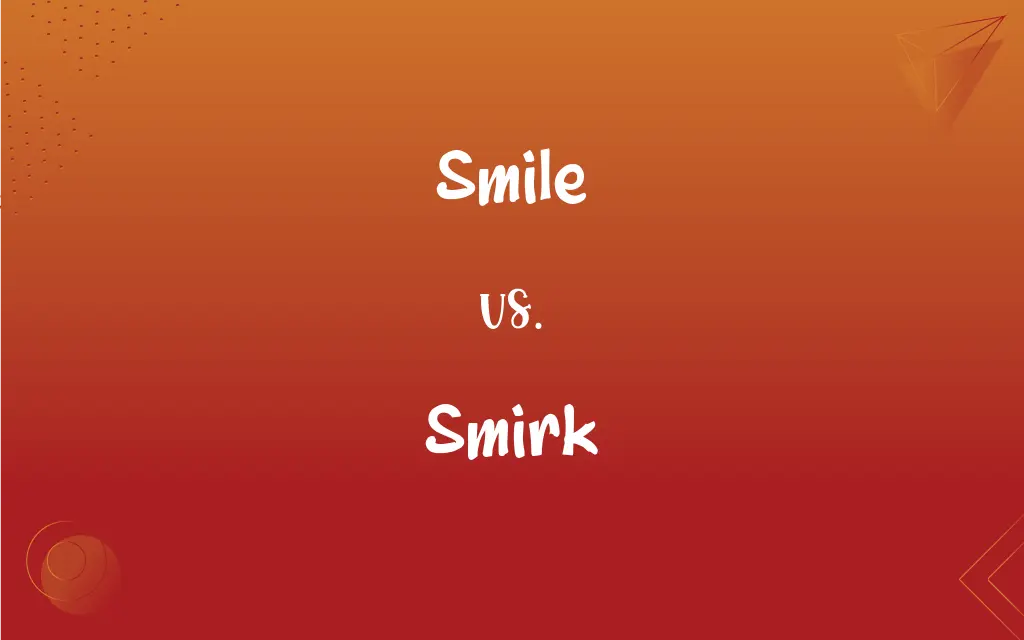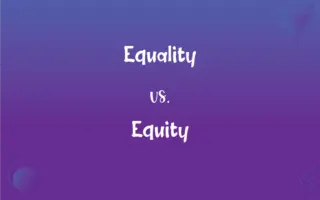Smile vs. Smirk: What's the Difference?
Edited by Aimie Carlson || By Harlon Moss || Updated on October 20, 2023
Smile is a genuine expression of happiness; smirk suggests smugness or sarcasm.

Key Differences
A smile is a universal gesture, showcasing happiness, warmth, or friendliness. On the contrary, a smirk is often perceived as self-satisfied, derisive, or can even hint at condescension. Both expressions form on the face, yet the emotions they emanate can be vastly different. While a smile signifies a positive emotion and is often appreciated, a smirk can be ambiguous and is sometimes viewed with skepticism.
In various cultures, a smile is seen as an invitation of trust and openness. It can bridge gaps, mend relationships, and even communicate when words fail. In contrast, a smirk might indicate superiority or a form of contempt, making it less endearing. Both, however, are means of non-verbal communication, each carrying its own set of implications and interpretations.
When one thinks of a smile, the image that comes to mind is often that of joy, warmth, or friendliness. It’s a universal symbol of goodwill. But a smirk brings forth images of slyness, perhaps even deceit. The distinction lies not just in the curvature of the lips but the intent behind the gesture.
One fascinating aspect of human interaction is how facial expressions can convey messages without uttering a word. A smile can comfort, welcome, or congratulate. A smirk, on the other hand, can mock, belittle, or challenge. These two facial gestures, while similar in appearance, are distinct in emotional resonance and interpretation.
Comparison Chart
Emotional Connotation
Generally positive, expressing happiness or pleasure.
Often negative or neutral, hinting at smugness.
ADVERTISEMENT
Universality
Universally recognized as a gesture of goodwill.
Can be ambiguous, sometimes viewed with skepticism.
Common Usage
Used to convey joy, approval, or to welcome someone.
Used to show superiority, disdain, or amusement.
Facial Movement
Involves more facial muscles, especially around the eyes.
Typically limited to one side of the mouth.
Cultural Perception
Widely accepted as a friendly gesture across cultures.
Can be seen as disrespectful in certain contexts.
Smile and Smirk Definitions
Smile
A symbol of approval or acceptance.
His presentation was met with smiles from the audience.
ADVERTISEMENT
Smirk
A self-satisfied or conceited smile.
He had a smirk on his face after winning the bet.
Smile
An act of kindness or friendliness.
Even a small smile can make someone's day.
Smirk
A smile suggesting insincerity or sarcasm.
She watched the scene unfold with a knowing smirk.
Smile
An expression showcasing happiness.
When she heard the news, her face lit up with a smile.
Smirk
An expression of scorn or contempt.
She gave a smirk when she saw her competitor falter.
Smile
A facial gesture of goodwill.
She greeted every customer with a warm smile.
Smirk
A sly or smug facial gesture.
Every time he knew something others didn't, he'd give a little smirk.
Smile
The upward curve of lips displaying positivity.
Despite the challenges, she wore a brave smile.
Smirk
A derisive smile showing superiority.
He couldn't help but smirk when he proved them wrong.
Smile
A facial expression characterized by an upward curving of the corners of the mouth and indicating pleasure, amusement, or derision.
Smirk
To smile in an annoying self-satisfied manner.
FAQs
What emotion does a smile generally convey?
A smile generally conveys happiness or friendliness.
Can a smirk be misinterpreted?
Yes, smirks can be ambiguous and may be viewed differently based on context.
Are smiles universally understood?
Yes, smiles are generally understood across cultures as a gesture of goodwill.
Why is a smirk sometimes called a "half-smile"?
Because it often involves just one side of the mouth, unlike a full smile.
How can one differentiate between a genuine smile and a forced one?
Genuine smiles often reach the eyes, while forced ones primarily involve just the mouth.
Can a smile be insincere?
Yes, sometimes people smile out of politeness rather than genuine happiness.
Is a smirk considered a type of smile?
While similar, a smirk is more specific and can suggest smugness or sarcasm.
What facial muscles are primarily involved in smiling?
Smiling involves various facial muscles, especially around the eyes and mouth.
Is smirking a modern expression?
No, the concept of smirking has been around for a long time, though its interpretation might vary.
Is smiling beneficial for health?
Yes, smiling releases endorphins, which can improve mood and reduce stress.
Can a smirk be playful rather than malicious?
Absolutely, context and relationship with the person smirking can influence its interpretation.
How often do people smile in a day?
It varies, but studies suggest that adults smile about 20 times a day on average.
Can smirking be unintentional?
Yes, some people might smirk unintentionally, without any underlying malice.
Is it true that smiles are contagious?
Yes, seeing someone smile can often prompt others to do the same.
Is smirking always negative?
Not always, but it often carries a tone of smugness or sarcasm.
What is the main difference between a smile and a smirk?
A smile generally indicates happiness or warmth, while a smirk suggests smugness or sarcasm.
Do all cultures interpret smirks the same way?
No, cultural differences can affect how smirks are perceived.
What's the link between smirking and sarcasm?
A smirk often accompanies sarcastic remarks, hinting at the speaker's insincerity.
Do smiles always indicate happiness?
Not always. People might smile out of politeness, discomfort, or other emotions.
Can animals smile?
While animals have ways of showing contentment, human-like smiling is unique to humans.
About Author
Written by
Harlon MossHarlon is a seasoned quality moderator and accomplished content writer for Difference Wiki. An alumnus of the prestigious University of California, he earned his degree in Computer Science. Leveraging his academic background, Harlon brings a meticulous and informed perspective to his work, ensuring content accuracy and excellence.
Edited by
Aimie CarlsonAimie Carlson, holding a master's degree in English literature, is a fervent English language enthusiast. She lends her writing talents to Difference Wiki, a prominent website that specializes in comparisons, offering readers insightful analyses that both captivate and inform.































































